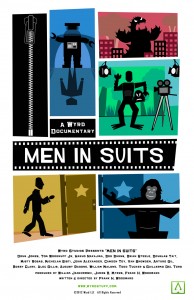 Computer-generated imagery and motion-capture are all the rage in special effects today, but actors in monster suits can still be found as well. They tap into a form of special effects work, as well as an art form, that goes back for decades in cinema.
Computer-generated imagery and motion-capture are all the rage in special effects today, but actors in monster suits can still be found as well. They tap into a form of special effects work, as well as an art form, that goes back for decades in cinema.
Frank Woodward and the team at Wyrd Films have produced a documentary that explores this subject in MEN IN SUITS. Below is our interview on this topic.
TheoFantastique: Frank, thanks for coming back here to discuss your latest film. Readers may remember your documentary on Lovecraft: Fear of the Unknown. How did the original concept arise in terms of focusing on those unsung heroes of genre films, actors in suits?
Frank Woodward: I think it helped that I was already a monster fan. I knew the names Tom Woodruff, Jr., Bob Burns, Nakajima, Brian Steele, Doug Jones. They were talented actors in my mind and it was always vexing that most people didn’t know who they were. Godzilla, Predator and the Gill Man are icons of cinema yet, unlike James Bond or Indiana Jones, most people can’t tell you who played these characters.
When I started brainstorming about our next documentary with fellow Wyrd producers Jim Myers and Bill Janczewski, the first thing we came up with was a history of make-up. That was immediately seen as too broad and something that had been done to death. We focused on guys in suits because we couldn’t think of any film that explored that topic in depth.
What really convinced us though was when Bill told his wife Stacy about the idea. “We’re thinking about doing a documentary about guys who wear creature suits.” Her response was, “That’s a job?” It was no question after that.
And MEN IN SUITS is made for more than fanboys already in the know. We made the film to show that it’s not only a job…it’s an art.
TheoFantastique: You assembled quite a cast of interview subjects for this documentary. I would assume this is a tight knit group of people who were excited about the opportunity to talk about their work. Is this the case?
Frank Woodward: Most of these guys are familiar with each other for sure. In some cases like Doug Jones and Brian Steele they’ve worked together on a few films. All of them seemed happy to be part of a documentary that finally acknowledged the work they put into their roles.
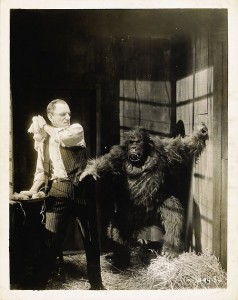 The term “suit performer” which is often used to describe what these people do really sells them short. It makes them anonymous more than any gorilla head does. These people are actors and have put in that level of training. I hope SUITS can show this to people.
The term “suit performer” which is often used to describe what these people do really sells them short. It makes them anonymous more than any gorilla head does. These people are actors and have put in that level of training. I hope SUITS can show this to people.
TheoFantastique: Your film begins with a historical perspective, looking at some of the early “men in suits,” from robots and aliens to gorillas and other apes. Who were some of the early pioneers in this form synthesis of special effects and character acting?
Frank Woodward: Animal roles like apes and bears were among the first guys in suits Hollywood required. We’re talking back in the 1930s. Gorilla men like Charlie Gemora and Janos Prohaska really brought something to their roles. It wasn’t just a P.A. in a furry suit.
In the case of Charlie, he played monster gorillas and comedic ones. Those genres require different timing and it takes an actor to make that work. Charlie Gemora held his own opposite Lon Chaney, Bela Lugosi, Lou Costello and The Marx Brothers. That shows a wide range.
And many Gorilla Men like Charlie and Ray “Crash” Corrigan went on to play aliens and such. Charlie was the Martian in THE WAR OF THE WORLDS. “Crash” was the alien in IT! THE TERROR FROM BEYOND SPACE.
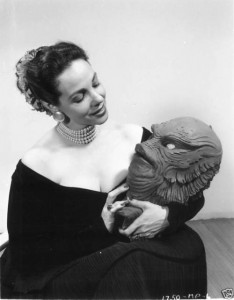 TheoFantastique: I was pleased to see The Creature from the Black Lagoon recognized as providing special legitimacy to this craft. How did that film contribute to this unique form of work?
TheoFantastique: I was pleased to see The Creature from the Black Lagoon recognized as providing special legitimacy to this craft. How did that film contribute to this unique form of work?
Frank Woodward: As Bob Burns says in the documentary, “The Creature changed things.” In this case it started with the suit. The Gill Man designed by Millicent Patrick is simply elegant. It was also above and beyond the average monster of the 1950s which were often made on a shoe-string.
What also made the Gill Man stand out were the two actors portraying him: Ben Chapman and Ricou Browning. Chapman played the creature on land, Browning in the water. In the case of Browning, he had a unique swimming style that gave the Gill Man that extra something. It made him seem alien. An extra layer hiding the human inside.
You take all of these factors and put them in a solid movie with more than the usual B-movie budget behind it…you get a classic!
TheoFantastique: I also enjoyed the international dimension of your film which included a look at Haruo Nakajima with his work on Godzilla and Ultraman. How did Japanese genre film make a unique contribution to this work?
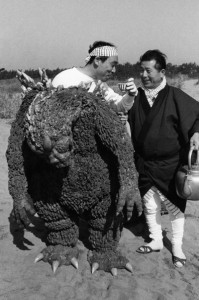 Frank Woodward: Well, you can’t talk about guys in suits without mentioning Godzilla. The Japanese made kaiju films a cornerstone of their film industry. Godzilla also had international appeal and I think that was due to a very distinct character that evolved throughout the films. Like King Kong, Godzilla wasn’t a mindless beast.
Frank Woodward: Well, you can’t talk about guys in suits without mentioning Godzilla. The Japanese made kaiju films a cornerstone of their film industry. Godzilla also had international appeal and I think that was due to a very distinct character that evolved throughout the films. Like King Kong, Godzilla wasn’t a mindless beast.
I mention King Kong because that was the inspiration for special effects wizard Eiji Tsuburaya (who designed the suits and directed all the creature scenes for Toho’s kaiju films until the 1970s) and actor Haruo Nakajima. Tsuburaya and Nakajima watched KING KONG before shooting GODZILLA. I think you can see the influence.
In the end, though, I think the greatest contribution made by kaiju films is that they’re just so damn fun! One of the first movies I ever saw was GODZILLA vs. THE SMOG MONSTER so I was imprinted early on.
TheoFantastique: At one point in the film there is an acknowledgment of the fear that CGI would destroy suit work just as it largely did stop-motion animation. How have things changed in the industry after a short dry spell for suit actors?
Frank Woodward: I think we’re seeing a mixture of digital and practical more than we did in the honeymoon days of CGI. We’re seeing digital expand and enhance the practical like the Faun’s legs in PAN’S LABYRINTH.
The problem with CGI comes when you overuse it. Magicians say that you should never do the same trick one after the other because eventually the audience will be able to see the trick. This tends to be the problem with films that only do CGI effects. We get wise to it. It’s why films like THE LORD OF THE RINGS succeed so well. They mix miniatures and forced perspective with CG. Practical creatures with motion capture ones.
The biggest problem with CGI as I see it is that producers still think it’s a cheaper solution than doing it practical. Why have a whole crew waiting for the animatronic head to work right when you can give it to one guy at a computer? The thing is that to get motion picture level CGI takes just as much time and in many cases just as much money It’s a wash.
The other thing about CGI vs. practical is you don’t get anything for free. Every turn of the head or twitch of the finger requires someone to animate that in the CG world. An actual actor on set with a symphony of actions and behavior can give you life-like moments for free.
Even Mo-Cap isn’t a guarantee of a full performance. It’s rarely one to one. Animators always have to fill in the blanks that weren’t captured. No offense to Andy Serkis because he brings such a rich foundation to all his roles, but Gollum was also created by a host of animators.
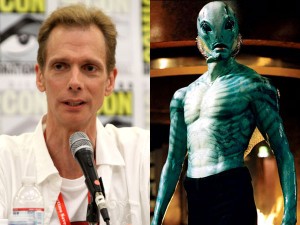 This is true of practical creatures, too. It takes an actor like Brian Steele and a team of puppeteers to realize a character like Mr. Wink in HELLBOY II. It’s just that the current fascination with mo-cap seems to say that actors in leotards with shiny balls can do it all. That’s simply not true.
This is true of practical creatures, too. It takes an actor like Brian Steele and a team of puppeteers to realize a character like Mr. Wink in HELLBOY II. It’s just that the current fascination with mo-cap seems to say that actors in leotards with shiny balls can do it all. That’s simply not true.
What’s worse is that some producers and studio heads are actually buying their own hype. Look at a film like RISE OF THE PLANET OF THE APES. Not a practical ape in there as far as I know. And we’ve been doing realistic gorillas for decades now.
TheoFantastique: As you said earlier, many except for the most devoted fans would not recognize these actors because their faces are hidden in layers of rubber and mechanics. Was your film an attempt to bring some much needed attention and respect to these actors?
Frank Woodward: Definitely. These are deeply talented actors and they deserve all the respect and honors their fellow actors receive. Like I said before… it’s a shame that someone can tell me Sean Connery played James Bond, but hardly anyone can tell me Haruo Nakajima played Godzilla. And I think the big green guy has appeared in more films than Bond.
TheoFantastique: What was your favorite moment in the making of this film?
Frank Woodward: Meeting a lot of my heroes. Realizing how generous and delightful they are. This monster kid got to make a movie about monsters and the folks who played them. How cool is that?
There was also that time that Godzilla gave me a big bear hug. Mr. Nakajima is over 80 and he nearly broke some ribs. That will stay with me forever.
TheoFantastique: Frank, thanks again for a great film, and for this interview.
MEN IN SUITS can be purchased in the TheoFantastique Store.
Related post:
“Lovecraft: Fear of the Unknown Documentary – Director Frank Woodward Interview”





There are no responses yet